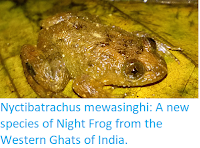Fanged Frogs, Limnonectes
spp., are unique among Frogs in that the males are typically larger than the
females, and frequently fight for territories, the females then mating with the
males perceived as having the best territories in which to lay their eggs, a
reproductive strategy common among Fish and Mammals, but otherwise unknown
among Amphibians. The males show several adaptations to this lifestyle, notably
enlargement of the head, which in extreme cases can comprise half the
body-length, and the development of fang-like protrusions on the lower jaw,
which give the group its common name.
In a paper published in the journal ZooKeys on 16 May 2019, Somphouthone Phimmachak of the Department of Biology at the National University of Laos, Stephen Richards of the Herpetology Department at the South Australia Museum, Niane Sivongxay, also of the Department of Biology at the National University of Laos, Sengvilay Seateun, agian of the Department of Biology at the National University of Laos, and of the Department of Zoology at Kasetsart University, Yodchaiy Chuaynkern of the Department of Biology at Khon Kaen University, Sunchai Makchai of the National Science Museum, and Hannah Som and Bryan Stuart of the North Carolina Museum of Natural Sciences, describe a new species of Fanged Frog from central and southern Laos and northeastern Thailand.
The new species is named Limnonectes savan, where 'savan' means 'paradise' in Lao, and is a common shortening of Savannakhet Province in Laos, where the species was first discovered, and where it appears to be most numerous. These Frogs have broad, flat heads and stocky bodies that taper towards the groin. The limbs are also robust, though with slender toes. The skin is covered with tubercles, and brown or tan in colour with a grayish white underside; some specimens have a pale vertebral stripe that runs from the tip of the snout to the vent. Females are less robust than the males.
Limnonectes savan in life. (A) Lateral view of male. (B) Lateral view of female. Phimmachak et al. (2019).
The species was found living in Savannakhet, Khammouan, and Champasak provinces in Laos and Ubon Ratchatani Province in Thailand; it may also be present in Amnat Charoen Province in Thailand. It occurs in hill and semi-evergreen forests at altitudes of between 254 and 790 m, Typically being found in or near narrow streams (less than 3 m across) or pools. It breeds in puddles on the forest floor in the rainy season.
Habitat of Limnonectes savan in Savannakhet Province, Vilabouli District, Laos in December 2008 at (A) Houay Khalai Stream, Ban Khalai Village, and (B) Houay Hong Stream, Ban Houay Hong Village. Phimmachak et al. (2019).
See also...
Follow Sciency Thoughts on Facebook.









